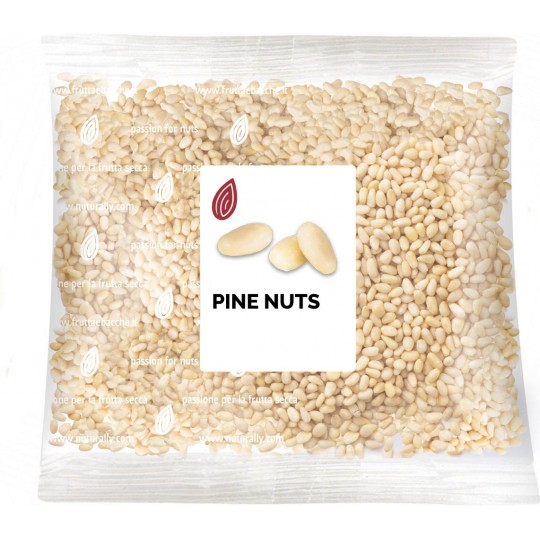


Buy online Siberian pine nuts with no preservatives.
Our Siberian pine nuts are small and roundish and grow in a natural way in the Siberian taiga.
You can buy natural Siberian pine nuts in packs that are ideal for true nuts lovers. Discover the nutritional values of natural Siberian pine nuts. Our analyses have shown that 100 g of raw Siberian pine nuts contain:
Ingredients: Pine nuts
Format: 500 g
Origin: Russia, Kazakhstan

Ethical quality

Affordable price

Esclusively on Nuturally

Nutritional values
| Ingredients | Pine nuts. May contain traces of PEANUTS and other NUTS. |
| Weight | 500g |
| Storage requirements | Store in a cool, dry place |
| Nutrition declaration | average nutritional values per 100 g: |
| Energy | 2838 kJ / 687 kcal |
| Fats | 63 g |
| of which saturates | 5.5 g |
| Carbohydrate | 10 g |
| of which sugars | 4.6 g |
| Fibre | 3.9 g |
| Protein | 18 g |
| Salt | 0 g |
| Copper | 1.1 mg (110% NRV*) |
| Manganese | 5.6 mg (280% NRV*) |
| Vitamin E | 12 mg (100% NRV*) |
| Source | Euro Company analysis |
| Recommendations | The advice provided SHOULD IN NO WAY BE CONSIDERED AS MEDICAL ADVICE OR PRESCRIPTION. The information provided shall be considered for informative and educational purposes only, it is not intended to replace medical advice. In case of a medical condition, always consult your doctor. |
| Origin | Kazakhstan, Russia |
| Nutrients | Copper, Manganese, Vitamin E |
| *NRV: Nutrient Reference Value | *Nutrient Reference Value |
| Label and packaging | The images are for illustrative purposes only, the product may be subject to changes depending on stock availability and selected weight. |
| Product | Pine nuts |
Curiosity
Our Siberian pine nuts grow naturally in the Siberian taiga. Harvesting takes place in October and November, namely months in which farmers harvest the pine cones in the forest.
The Pinus Sibirica is a common species in central-southern Siberia as well as in the far east of Russia. They are rather small and rounded pine nuts, but are known among Siberians as high quality and healthy food.
Source:
Nutspaper 2/2015
History
Symbol of death and resurrection, the pine tree was considered a tree of divine references. Starting from its pine cones, whose shape refers to the egg, which is associated with birth and fertility, the tree was celebrated by the populations of the Mediterranean area, including Etruscans, Greeks, Celts and Romans. Famous in ancient Rome was also the ritual belonging to the feast of Arbor Intrat, in which the consecration of the pine tree took place following the myth of Atys. It is said that Atys, a young inhabitant of Phrygia, was so beautiful that he conquered the goddess Cybele herself, becoming her passionate lover. The King of Pessinunte (the ancient kingdom of Midas) was convinced that the boy had been subjugated and decided thus to separate him from the goddess by offering him his daughter in marriage, thus angering Cybele who manifested herself during the wedding by playing a Pan flute (the traditional ritual instrument also of the Etruscans, called aulos). The sound of the flute drove all the guests mad, including Atys himself who mortally mutilated himself with a knife. Zeus, moved to pity for the story, wanted to turn him into an evergreen pine tree, gifting him eternity.
Some people reported what has been called Pine Mouth Syndrome, that is a strong feeling of bitterness in the mouth after 24-48 hours after ingesting certain species of pine nuts, a feeling that in some cases lasted up to two weeks. The cause has been found in a variety of Chinese pine nuts from the Pinus armandii tree that China has been isolating, in order to avoid similar problems in the future. Following appropriate analysis, scientists have agreed on the fact that, despite the sensation felt after ingesting this type of pine nuts may be unpleasant, the reaction has no remarkable effects on health.
Source:
Nutspaper
Properties
According to our analyses, 100 g of Siberian pine nuts contain:
Affordable price
Affordable price means to us offering our clients natural Siberian pine nuts that everybody can enjoy.
We want, on the one hand, to place the proper value on raw materials in order to obtain a quality product by paying our farmers a fair price; on the other hand, we want to fulfil your needs when it comes to pricing.
We establish fair long-term relationships with our producers to avoid race-to-the-bottom pricing and that are based on trust as part of our efforts to offer you the finest and most natural product.
Not only that: by choosing large packs of natural Siberian pine nuts, you are also contributing to the reduction in the use of plastic.
How much does 1 kg of Siberian pine nuts cost?
The price per kg for Siberian pine nuts depends on the Siberian pine nuts' quality, variety and origin. On Nuturally, we have selected the best Siberian pine nuts with respect for our supply chain, farmers, and raw materials.
Storage
You can store natural Siberian pine nuts in cool, dry places away from heat and moisture. Here are 4 useful tips:
Questions & Answers by Nut lovers
Be the first to ask a question about this product!